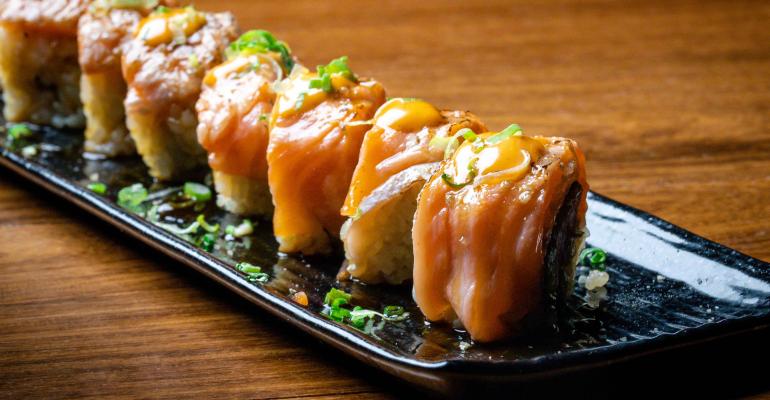John Park, owner of San Francisco’s new Japanese-infused Peruvian Nikkei-style restaurant KAIYŌ Rooftop, said the grand opening of their new 12th-floor eatery was “overwhelming.”
“What we didn’t really scale and really understand was the kind of interest and excitement for the space in San Francisco. I think it's coupled with this cooped up tension that people want to get back to normalcy from the pandemic,” he said of the Feb. 16th opening.
KAIYŌ Rooftop is located on the 12th floor of the Hyatt Place Hotel in the SOMA neighborhood. The 3,300-square-foot restaurant accommodates 236 people.
For Park, managing partner of Brick x Brick Hospitality Group, it is an extension of the group’s original KAIYŌ in the Cow Hollow neighborhood. Brick x Brick also operates the restaurants Whitechapel and Novela, and the new rooftop concept precedes another location of KAIYŌ scheduled to open on the ground floor of the Hyatt Place Hotel later this year.
In the new elevated space, which offers panoramic views of the San Francisco skyline and nearby sports stadiums, Park hopes to give KAIYŌ a bigger stage.
Park, in partnership with William Duff Architects, designed and decorated KAIYŌ Rooftop with “contemporary decor and natural finishes, vibrant pops of color and lush greenery accents, including live palm trees,” according to press materials. There’s also a rainforest-inspired mural on site created by artist Jeff Carnie.
The theme is purely Peruvian-Japanese. Chef Alex Reccio, who is originally from Lima, Peru, is working alongside sushi chef Rafeal Campo and bar manager Carl Brown on food-and-beverage offerings.
Reccio said people can expect a unique approach to Nikkei and Peruvian cuisine at KAIYŌ Rooftop.
“They're going to see Rafeal’s sushi menu, they're going to try our cocktail menu and they're going to be surprised. I think that's the first reaction people have when they first try our concept,” he said.
Nikkei cuisine is often described as a blend of Japanese and Peruvian flavors, but it represents a style of cooking that has evolved from generations of Japanese immigrants now rooted in Peru.
Park said what makes this restaurant unique is that it’s blending the past, meeting the present and pushing forward the future of Nikkei cuisine by using what they can in today’s broken supply chain market, evolving and creating along the way.
“The beautiful thing about this story is that it is the journey of Nikkei cuisine becoming a form. It's people that have these deep Peruvian cultures that understand Japanese food and are trying to create the Japanese experience, but those ingredients would never be available to them. And that's exactly what the immigrants the Japanese were experiencing in Peru. How do I eat the sushi that I want to eat without the ingredients I usually have in Japan?” he said.
Campo, Reccio and Brown all speak about the challenges lingering from two years of pandemic.
“It's been difficult,” Reccio said. “Purveyors let most of their people go during COVID, so they weren’t ready for the beginning of the year when things were opening up again. We are trying to manage our ordering as consciously as possible. There's items that we need to import like Peruvian chilies, for example.
“Some things need to be imported but we try to be as local as possible not because of the freshness of it but because of what’s been going on during COVID, and after COVID, with the whole supply chain and demand of the product,” he continued.
However, adds Campo: “Some of the best food comes from struggle.”
Brown said he’s finding challenges with certain Japanese whiskeys and sakes but making it work with substitutes.
Signature drinks on the menu include a signature $13 Pisco Sour, made from Pisco, a grape-based brandy produced in Peru, combined with fresh squeezed lime and lemon juice, and egg white. There are large-format drinks, such as Koro’s Big Day ($52, serving four) with aji amarillo-inflused Barsol Pisco, mezcal, pineapple juice, lime and agave; as well as tropical and fruit cocktails, highballs and mocktails with Seedlip Garden.
As for sushi, there’s Nigiri or specialty rolls such as the Lima roll and crab causa roll. The crab causa roll is a Peruvian mashed potato roll with crab pulp mix, aji amarillo causa dough, lemon juice, avocado, cucumber, nori, jalapenos, cilantro aioli, roasted red pepper relish, micro cilantro, and cancha crumbs. The Lima roll comes with shrimp tempura, yellowtail, avocado, rocoto aioli, aji verde, unagi sauce, and shiso chiffonade.
Small plates include pork bao buns ($14); wagyu gyoza ($18); and papas fritas with a togarashi, aji amrilloa sauce ($5).
There are seafood platter options for two ($75) or four ($110); as well as ceviches ($18-$22) and tiradito (like sashimi; $16-$22). The latter is served with “leche de tigre,” or tiger’s milk, which refers to the citrus-based marinade that cures the ceviche and tiradito, along with the fish juices, which is served in a small glass and touted as both a hangover cure and aphrodisiac.





